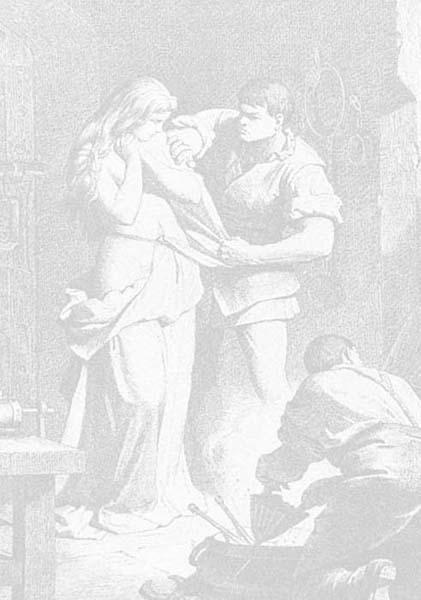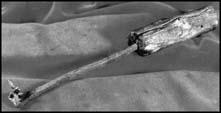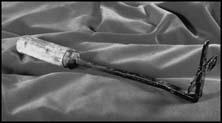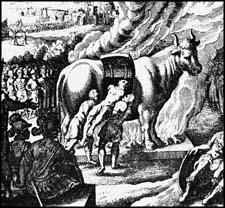The Big Book of Pain: Torture & Punishment Through History (32 page)
Read The Big Book of Pain: Torture & Punishment Through History Online
Authors: Daniel Diehl


This is an example of the judas cradle upon which a victim would be sat … their hands (and sometimes feet) secrurely bound and weights (such as the one pictured here) locked around their ankles pulling them down deeper onto the unrelenting spike.
Section III
I
n the previous sections of this book we investigated a variety of torture methods as they occurred within the historical context of their times and geographic locations. In order to keep to our historical structure, we found it necessary to skim over many types of torture and, in some cases, eliminate specific torture devices and techniques altogether. In this section, which is divided into various methods of torture and sub-divided by specific types of torture, we hope to present a more comprehensive description of those tortures covered in the previous sections and also explain many types of torture previously unmentioned. Here then, submitted for your approval (or disgust), is a catalogue of cruel, bizarre and often outrageous punishments employed by mankind over the centuries.



TORTURE BY BURNING AND BRANDING
BRANDING
F
rom Classical Rome through most of the eighteenth century, searing a convict’s flesh with a hot iron was considered a valid way to ensure that miscreants would endure perpetual punishment by being ostracised from respectable society. If a person’s shame was irrevocably burned into their skin (usually on the hand or face) they would never be able to hide from their past convictions; indeed, when a person appeared in court they were required to hold up their hand to determine if they bore brands from previous convictions – hence the custom of holding up the right hand when being sworn in for testimony. The type and location of brands varied with the country and manner of the crime, but here are a few examples. Rome branded recaptured, escaped slaves with an ‘F’ for
fugitivus
and in eighteenth-century England those who spoke out against the government were branded with ‘SL’ for seditious libeler. A rogue’s hand was branded with an ‘R’, thieves with a ‘T’, liars bore the letter ‘F’ for falsehood and vagabonds (now referred to as the wandering homeless) were marked with a ‘V’. Perjurers’ foreheads were permanently decorated with a ‘P’ and those who took the Lord’s name in vain received a ‘B’, for blasphemer, in the same place. Military deserters’ armpits were branded with a ‘D’ and soldiers convicted of bad conduct received a ‘BC’ in a similar location. There were many other common brands and innumerable local variations as well as different letters designating these same offences as applicable to various languages. The French also adopted the practice of burning a convict’s sentence into their skin, hence someone sentenced to hard labour received a ‘TF’ brand meaning
travaux forces
and those condemned to perpetual hard labour were marked ‘TPF’ for
travaux a perpetuite
, and a thief might be branded with a ‘V’ for
voleuse
.

Branding iron.

Branding iron.
BORING WITH A HOT IRON
Similar to branding (see above). Throughout the Middle Ages and until the end of the eighteenth century, petty criminals were routinely subjected to having holes burned through various parts of their bodies with a hot iron, not unlike a small fireplace poker. Liars, perjurers and blasphemers were likely to have a hole burned through their tongues while petty thieves and drunkards were more likely to have a hole seared through one, or both, of their ears. See also the section on Chinese torture for the punishment meted out to libidious monks.

Brazen bull.
BRAZEN BULL
This ingenious study in depravity was unique to the ancient Sicilian city-state of Acragus (now known as Agrigentum) during the reign of the tyrant Phalaris. The eponymous device was no more than a hollow, life-sized statue of a bull with a door in its side large enough to shove a man into the belly of the statue. When the victim had been jammed in place and the trapdoor locked, a fire was lit beneath the statue, heating it red hot. The screams of the condemned man could be heard through the open mouth and nostrils of the figure and were supposed to sound like an enraged bull.

Gridiron.
BURNING
Throughout history many crimes have led men and women to the burning stake, but this fearsome practice found its greatest acceptance during the religious persecutions and witch hunts that lasted almost continually from the early 1500s through the late 1600s. In both cases, because the crimes involved were considered to be crimes against God and the Church (be it Roman Catholic or Protestant) considered the act of burning a person condemned for heresy, or consorting with the Devil, as the only sure means of purging the evil from their souls. Horrible as being burned alive must have been, religious and civil authorities agreed that it was better for the body to suffer than for the soul to be condemned to eternal damnation. It was commonly believed that by making the person endure the unimaginable torments of hell while still on earth, they might at least stand some chance of eternal salvation. So many who witnessed such an horrific act as burning at the stake would not have viewed it as a gruesome spectacle, but rather as a charitable act of mercy and potential redemption inflicted upon some poor soul ‘for their own good’. It should also be noted that many of those who were burnt at the stake had already been strangled to death before their bodies were consigned to the flames. This small act of mercy was considered a courtesy to be bestowed upon those who at least showed some sign of repentance, but were too depraved and evil to be accepted back into decent society.